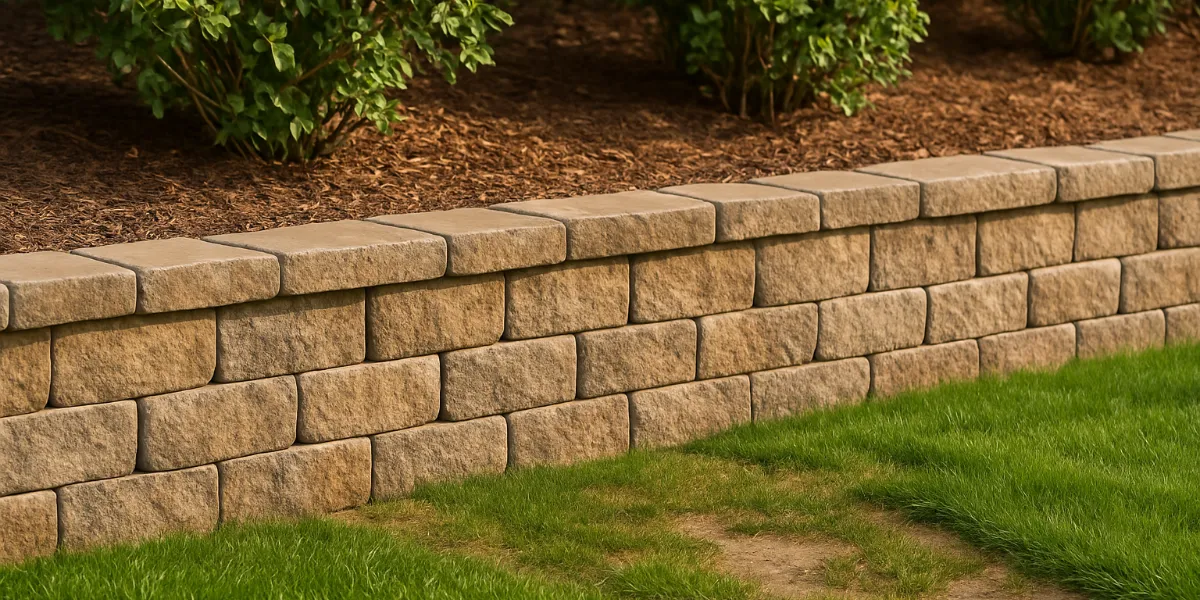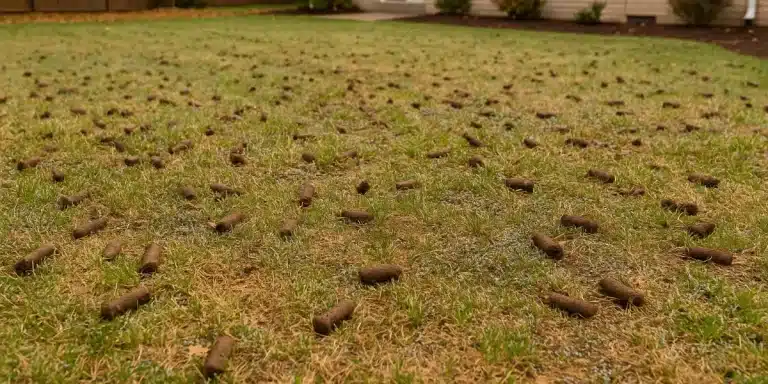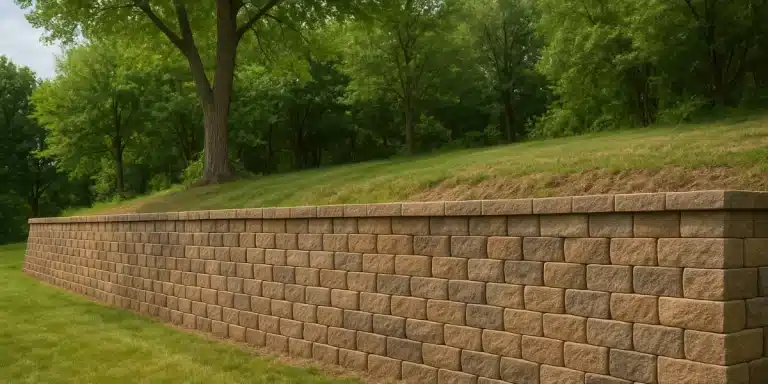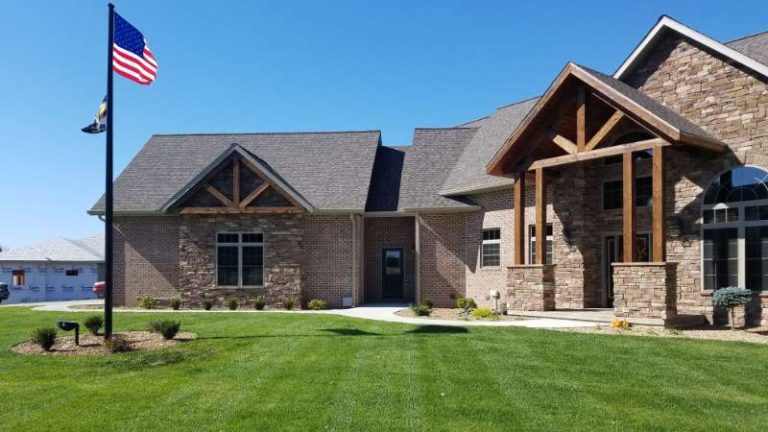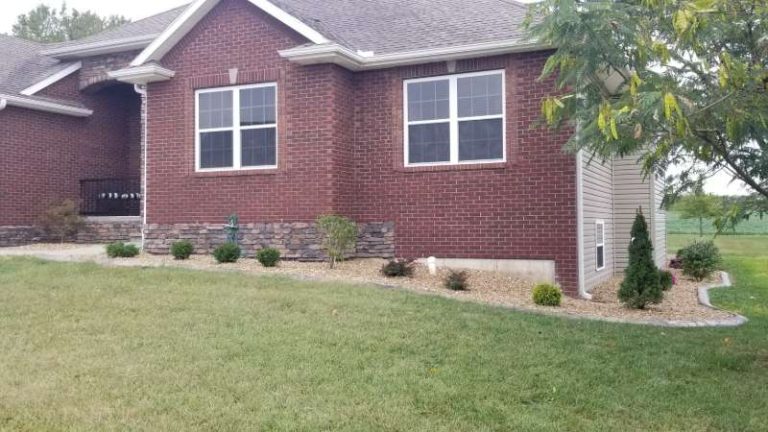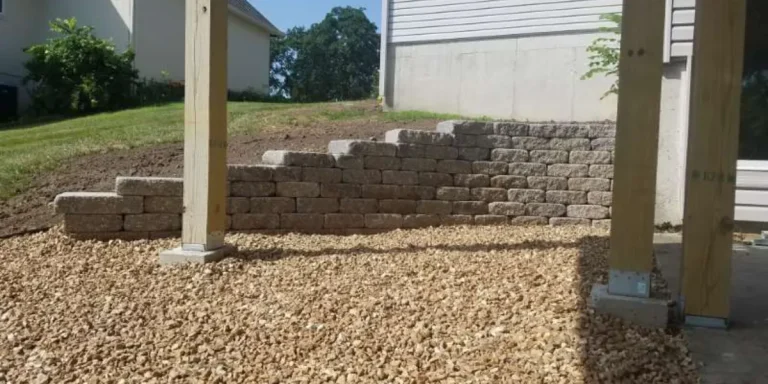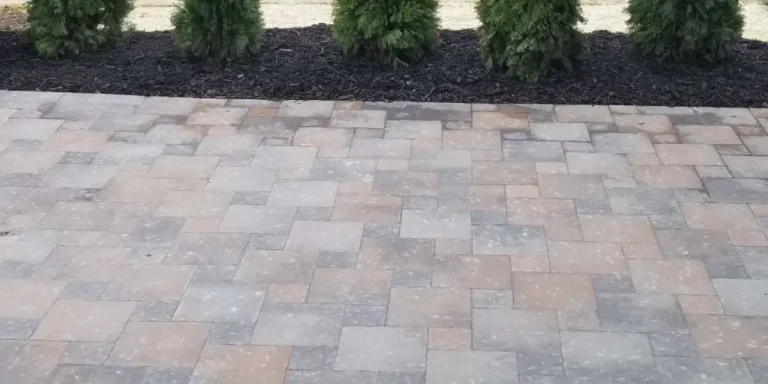What’s Causing Soil to Wash Out From My Retaining Wall?
If you’re seeing bare spots, gullies, or eroded areas behind your retaining wall, you’re not alone. Soil washout is a common issue in Missouri landscapes—especially after heavy rains. And while it may seem like just a cosmetic problem at first, erosion behind a retaining wall can lead to serious structural issues if left unaddressed.
At S&T Landscaping, we specialize in diagnosing and fixing drainage and grading issues around retaining walls. Let’s take a look at the most common causes of soil washout—and how we can help you fix it fast.
Why soil washes out behind retaining walls
Soil erosion behind retaining walls is a common issue, especially in areas like Central Missouri where heavy rains and clay soils can quickly cause trouble. While it might look like a minor nuisance at first, continued soil washout can weaken your wall’s structural integrity, increase pressure behind it, and eventually lead to failure.
In our experience at S&T Landscaping, soil erosion behind walls is almost always the result of one or more underlying issues with drainage, installation, or materials. Here’s a closer look at what might be going wrong:
Poor drainage behind the wall
The number one cause of soil washout is water that can’t properly drain away from the area behind the wall. Retaining walls are meant to hold back earth—not water. If that water gets trapped, it will find a way out, often by taking the surrounding soil with it.
Common drainage problems include:
-
- No gravel backfill: Properly constructed retaining walls should have a layer of coarse gravel or crushed stone behind them to allow water to flow freely toward the base and away from the wall.
- Missing or clogged drainage pipes: Perforated drain pipes (also called French drains) are typically installed behind larger walls to carry water away. If these are absent or blocked, water pressure builds up.
- Lack of weep holes: Weep holes allow water to exit through the face of the wall. Without them, moisture can saturate the soil and push its way out elsewhere.
- Improper grading at the base of the wall: If the ground doesn’t slope away from the wall, water pools instead of draining—weakening the wall and contributing to erosion.
Surface runoff from above
Even if the wall itself is built well, the slope of your yard or improper landscape grading can create excessive water flow toward the wall. This surface runoff is especially damaging during heavy storms or if irrigation systems are oversaturating the area.
-
- Uncontrolled downspout discharge: Gutter systems that drain directly onto sloped areas above the wall can create concentrated water flow that cuts through soil.
- Overwatering nearby lawns or garden beds: Regular irrigation on an incline can slowly erode the soil above the wall and push sediment down over time.
- Lack of diversion systems: Without swales, berms, or redirecting drains, surface water will take the path of least resistance—often directly into the base of your retaining wall.
Incorrect or insufficient backfill material
The space behind a retaining wall isn’t meant to be filled with just any type of soil. Clay-heavy or compacted dirt holds water, leading to pressure buildup and poor drainage.
Walls need:
-
- Clean, angular gravel or crushed rock to create air gaps and let water pass through easily.
- Geotextile fabric layers to separate gravel from soil and prevent clogging.
- Compactable layers that provide both support and filtration for long-term durability.
When these materials are skipped or substituted with cheaper fill, water has no proper exit—leading to soil migration and eventual wall movement.
Settling or shifting due to poor compaction
Soil must be compacted in layers during construction—not just dumped in all at once. If the base wasn’t compacted properly, or if backfill was loosely packed, the wall and surrounding soil can begin to shift over time.
This settling creates gaps where water can collect and flow, carving out soil behind the wall and accelerating erosion. You may notice dips in your yard, uneven pressure on the wall, or cracking mortar joints—all signs that the ground is no longer supporting the structure as intended.
Damaged or poorly built retaining wall
Not all retaining walls are created equal. DIY walls or older structures may have been built without proper reinforcement or drainage systems. Even smaller walls need some level of design consideration and engineering—especially on sloped properties or where heavy rain is common.
Common issues we see include:
-
- Cracked or crumbling blocks or stones
- Leaning or bowing sections from water pressure
- Lack of geogrid reinforcement in taller walls
- Improper use of landscape timbers or wood that’s begun to rot
These flaws allow water to breach the wall’s integrity and accelerate erosion behind it.
Signs your retaining wall may be at risk
Retaining wall failures often start subtly—long before the wall begins to lean or collapse. In many Central Missouri yards, the signs of a problem show up gradually as moisture, runoff, and soil movement begin to take their toll. If you know what to look for, you can catch these issues early and prevent costly repairs or rebuilds.
At S&T Landscaping, we regularly inspect and repair retaining walls throughout the Sedalia area, and we’ve found that early intervention makes all the difference. Here are some of the most common red flags that your wall may be in trouble:
Disappearing soil or mulch
If you notice that mulch, topsoil, or gravel seems to wash away after a heavy rain or irrigation cycle, that’s often a clear sign of erosion occurring behind or around the wall. You may see channels forming, sediment piling up at the base, or bare spots that weren’t there before.
-
- This can point to poor drainage or surface runoff flowing straight into the wall.
- Over time, repeated washouts can compromise the structural integrity of the wall.
Standing water or soggy soil behind the wall
Puddles, marshy areas, or constantly damp soil just behind your retaining wall often indicate a drainage problem. This excess moisture increases pressure on the wall and can force soil out through weak points.
-
- You might also notice algae or moss growth where water regularly sits.
- These symptoms usually mean it’s time for drainage solutions such as a French drain, gravel backfill, or grading work—services we frequently provide as part of our landscaping and hardscaping packages.
Gaps forming at the base
When water and soil escape, they often leave behind small but growing voids at the bottom of the wall. These gaps may look minor at first, but they create weak points that can spread quickly.
-
- Loose base stones, uneven ground, or separation from paved surfaces like patios or walkways are all worth investigating.
- Our retaining wall repair and reconstruction services can restore structural stability before a full collapse occurs.
Weeds growing through cracks
If grass, weeds, or even tree saplings are sprouting up in cracks between blocks or along the wall’s face, it means moisture is trapped inside—usually due to poor drainage or backfill issues.
-
- Weeds are opportunistic and tend to grow where soil is disturbed or shifting.
- Left alone, root systems can widen cracks and make the wall more vulnerable to movement.
Bulging or uneven wall sections
This is one of the more serious signs that your wall may already be shifting under pressure. If parts of the wall look bowed, tilted, or pushed outward compared to other sections, that means the load behind the wall is no longer being evenly supported.
-
- You may also see leaning fence posts, tilted caps, or horizontal cracking along mortared joints.
- In these cases, S&T Landscaping can evaluate whether reinforcement, rebuilding, or full replacement is the best course of action.
Even one or two of these signs could indicate a problem forming beneath the surface. By scheduling a professional inspection early, you may be able to correct drainage, stabilize the soil, or make minor wall repairs before major structural failure occurs.
How S&T Landscaping fixes soil washout problems
At S&T Landscaping, we take a long-term, structural approach to retaining wall repair and drainage solutions. Here's how we typically solve washout problems for homeowners in Sedalia and surrounding Missouri communities.
On-site inspection and diagnosis
We start with a full evaluation of your wall, yard slope, and drainage pattern. This helps us pinpoint the root cause—whether it’s poor backfill, clogged drains, or runoff from a higher part of your property.
Improve drainage behind the wall
In many cases, we’ll dig out behind the wall and:
-
- Add perforated drainage pipe (French drain)
- Replace poor backfill with clean gravel or rock
- Install weep holes or improve existing ones
This allows water to flow freely behind the wall without carrying away soil.
Redirect surface water
To reduce water pressure and runoff, we may recommend:
-
- Regrading parts of your lawn to redirect water
- Installing swales or dry creek beds
- Adding a surface drain or catch basin
These features not only protect your retaining wall but also improve your yard's function and appearance.
Rebuild or reinforce the wall if needed
If the wall is failing structurally, we can repair or replace sections using stronger, more modern methods. S&T Landscaping builds retaining walls that include proper compaction, geogrid reinforcement, and long-term drainage solutions—so your landscape stays intact for years to come.
Prevent future erosion with the right landscaping strategy
Fixing your retaining wall is a crucial first step—but without addressing the underlying causes of erosion, the same issues can return. At S&T Landscaping, we take a comprehensive approach that not only restores your retaining wall but also strengthens your entire landscape to resist future damage.
Our erosion control strategies are built around understanding your property’s unique drainage patterns, slope, and soil conditions. Once we identify the sources of the problem, we implement targeted solutions to redirect water, stabilize soil, and protect your outdoor spaces for the long haul.
Here are just a few of the landscaping and hardscaping services we offer to help prevent washouts around retaining walls:
-
- Landscape grading to redirect surface runoff
We re-contour your property to create a natural flow path for rainwater, preventing it from pooling or rushing toward your retaining wall. - Sod installation or low-maintenance landscaping for slope stabilization
Bare soil is especially vulnerable to erosion. We install turfgrass, groundcovers, or drought-tolerant plants that hold soil in place and absorb excess water. - Topsoil and mulch installation for added protection
A healthy top layer of organic material helps retain moisture without over-saturating and reduces the impact of heavy rains. This also improves soil structure and root development. - Custom drainage solutions, including French drains and dry creek beds
We design and install subsurface and surface drainage systems that carry water away safely. Whether it’s a perforated pipe system, gravel trench, or a decorative dry creek bed, these solutions are highly effective in protecting both your wall and yard. - Hardscaping enhancements like decorative rock beds or retaining swales
In areas prone to runoff, adding hardscape features can both improve aesthetics and manage water flow. We can install stone borders, small retaining mounds, or swales to capture and redirect water before it becomes a problem.
- Landscape grading to redirect surface runoff
By combining these services, S&T Landscaping ensures that your retaining wall—and your entire yard—has the support it needs to withstand Missouri’s unpredictable weather and heavy rain events. Whether you need a single drainage fix or a full landscape overhaul, we’re here to make your outdoor space stronger, safer, and more beautiful.
Proudly serving Sedalia and surrounding communities
S&T Landscaping provides expert retaining wall repair, drainage solutions, and landscape grading in:
-
- Sedalia
- Warsaw
- Osage Beach
- Lake Ozark
- Camdenton
- Sunrise Beach
- Laurie
- Benton County
- Pettis County
- Other nearby areas throughout Central Missouri
Don’t wait—fix your retaining wall before it gets worse
Stop erosion before it leads to a collapsed wall or costly repairs. If you're noticing signs of soil washout, reach out to S&T Landscaping today.
We’ll inspect your property, explain what’s going wrong, and give you a clear, affordable plan to fix it. Our expert team has helped hundreds of Missouri homeowners protect their landscapes—and we’re ready to help you next.
Call now or request your free estimate online. Let’s get your wall (and your yard) back on solid ground.

